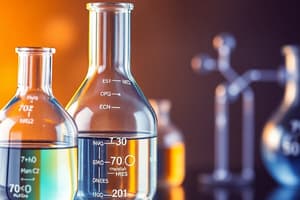Podcast
Questions and Answers
What is the definition of chemistry?
What is the definition of chemistry?
Chemistry is the scientific study of matter, its properties, composition, structure, and the changes it undergoes during chemical reactions.
Name two branches of chemistry and briefly describe their focus.
Name two branches of chemistry and briefly describe their focus.
Organic Chemistry studies carbon-containing compounds, while Inorganic Chemistry focuses on inorganic compounds like metals and minerals.
What are atoms and molecules?
What are atoms and molecules?
Atoms are the basic units of matter that make up substances, while molecules are formed when two or more atoms bond together.
What is stoichiometry?
What is stoichiometry?
How are groups and periods organized in the periodic table?
How are groups and periods organized in the periodic table?
Describe the technique of titration.
Describe the technique of titration.
What is the focus of analytical chemistry?
What is the focus of analytical chemistry?
List one real-world application of chemistry.
List one real-world application of chemistry.
Flashcards are hidden until you start studying
Study Notes
Overview of Cheamastry
- Cheamastry appears to be a typo and may refer to "Chemistry".
- If the focus is on a specific branch, please clarify.
Key Concepts in Chemistry
-
Definition: Chemistry is the scientific study of matter, its properties, composition, structure, and the changes it undergoes during chemical reactions.
-
Branches of Chemistry:
- Organic Chemistry: Study of carbon-containing compounds and their reactions.
- Inorganic Chemistry: Study of inorganic compounds, including metals, minerals, and organometallics.
- Physical Chemistry: Explores the physical properties and behavior of matter.
- Analytical Chemistry: Focuses on the analysis of material samples to understand their chemical composition and structure.
- Biochemistry: Study of chemical processes within and related to living organisms.
-
Key Concepts:
- Atoms and Molecules: Basic units of matter; atoms make up molecules.
- Chemical Reactions: Processes involving rearrangement of atoms to form new substances.
- Stoichiometry: The calculation of reactants and products in chemical reactions based on balanced equations.
- Acids and Bases: Substances that donate protons (acids) or accept protons (bases).
- Thermodynamics: Study of energy changes in chemical reactions.
- Kinetics: Study of rates of chemical reactions.
-
Periodic Table:
- Organized layout of chemical elements based on atomic number, electron configuration, and recurring chemical properties.
- Groups (columns) signify elements with similar properties; periods (rows) represent energy levels.
-
Laboratory Techniques:
- Titration: Technique to determine concentration of a solution.
- Chromatography: Method for separating mixtures based on differential affinities.
- Spectroscopy: Technique for analyzing substances based on interaction with electromagnetic radiation.
-
Real-world Applications:
- Pharmaceuticals development, agriculture (fertilizers, pesticides), material science, and environmental chemistry (pollution analysis).
Please provide any specific area of chemistry you'd like to focus on for more detailed notes.
Chemistry Definition
- Chemistry is the scientific study of matter.
- Matter includes its properties, composition, structure, and changes it undergoes during chemical reactions
Branches of Chemistry
- Organic Chemistry: Studies carbon-containing compounds and their reactions.
- Inorganic Chemistry: Focuses on inorganic compounds, including metals, minerals, and organometallics.
- Physical Chemistry: Explores the physical properties and behavior of matter.
- Analytical Chemistry: Analyzes material samples to learn their chemical composition and structure.
- Biochemistry: Studies chemical processes within and related to living organisms.
Key Concepts in Chemistry
- Atoms and Molecules: The basic building blocks of matter. Atoms combine to form molecules.
- Chemical Reactions: Chemical reactions rearrange atoms to form new substances.
- Stoichiometry: Calculates reactants and products in chemical reactions based on balanced equations.
- Acids and Bases: Acids donate protons, while bases accept protons.
- Thermodynamics: Studies energy changes in chemical reactions.
- Kinetics: Studies the rate of chemical reactions.
- Periodic Table: Organizes chemical elements based on atomic number, electron configuration, and recurring chemical properties.
- Groups (columns) in the periodic table show elements with similar properties.
- Periods (rows) represent energy levels.
Lab Techniques in Chemistry
- Titration: A technique to determine the concentration of a solution.
- Chromatography: Separates mixtures based on different affinities to a stationary phase.
- Spectroscopy: Analyzes substances based on their interaction with electromagnetic radiation.
Real-World Applications of Chemistry
- Pharmaceuticals development, agriculture (fertilizers, pesticides), material science, and environmental chemistry (pollution analysis).
Studying That Suits You
Use AI to generate personalized quizzes and flashcards to suit your learning preferences.




